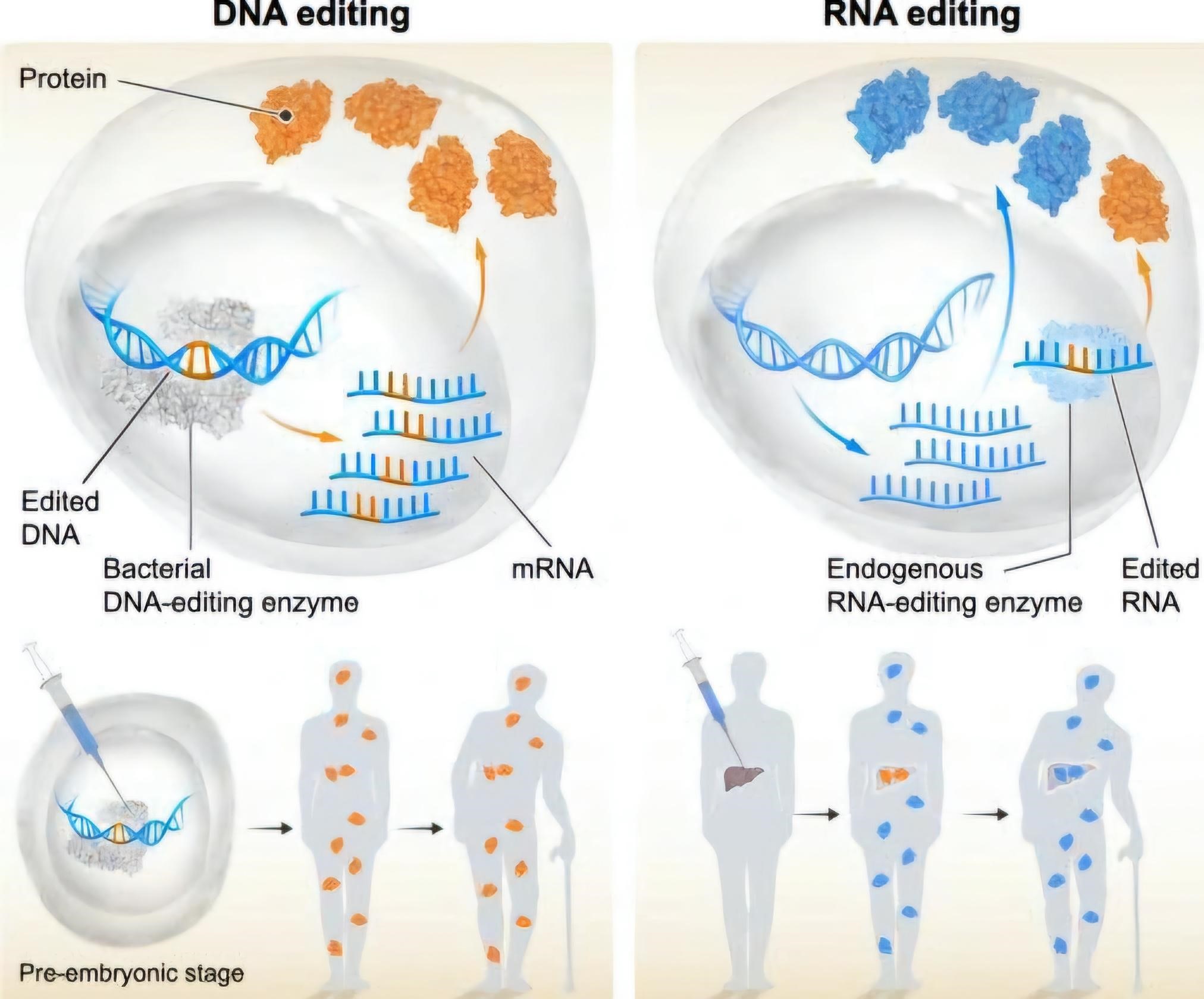RNA Editing: A Revolutionary Leap
Syllabus:
GS 2:
- Science and technology – Development and its application in everyday live.
- Life Science
Why in the News?
Wave Life Sciences, a U.S.-based biotech firm, recently became the first company to clinically treat a genetic disorder by editing RNA, highlighting the potential of RNA editing over DNA-based therapies.
Overview of RNA Editing
- Non-permanent changes: RNA editing offers temporary adjustments, unlike DNA editing, which can make irreversible changes. This allows therapy stoppage if issues arise, reducing long-term risks.
- Wave Life Sciences’ milestone: On October 16, Wave Life Sciences pioneered RNA-based therapy for a genetic disorder, paving the way for RNA applications in precision medicine.
- Role in RNA interference: RNA interference, which prevents gene expression, has supported CRISPR-Cas9’s success, emphasizing RNA’s role in gene regulation and beyond.
- Beyond gene expression: mRNA vaccines and recent advancements reveal RNA’s significance in biomedical science, elevating RNA editing to a vital tool in genetic medicine.
- New era in medicine: RNA editing promises groundbreaking changes in genetic treatment, potentially overcoming limitations faced by DNA-editing methods.
Key Differences between DNA and RNA
- Chemical Composition:
- DNA (deoxyribonucleic acid) contains deoxyribose, while RNA (ribonucleic acid) contains ribose.
- Ribose in RNA has an extra -OH group compared to deoxyribose, which has an -H at the 2′ carbon.
- Structure and Stability:
- DNA is a double-stranded molecule, making it more stable in alkaline conditions.
- RNA is single-stranded and less stable, especially under alkaline conditions.
- Functions:
- DNA stores and transfers genetic information essential for heredity.
- RNA helps in protein synthesis, coding for amino acids and acting as a messenger between DNA and ribosomes.
- Base Pairing:
- DNA bases: adenine (A), thymine (T), cytosine (C), and guanine (G).
- RNA bases: adenine (A), uracil (U), cytosine (C), and guanine (G), with uracil replacing thymine and lacking a methyl group.
- Role in Life:
- Both DNA and RNA are essential for life; without them, protein synthesis and energy productionwould not occur, halting all biological functions.
Mechanics of RNA Editing
- Messenger RNA (mRNA) role: Cells create proteins from mRNA instructions; RNA editing allows correction of errors in mRNA before faulty proteins are produced.
- ADAR enzymes in action: Adenosine deaminase acting on RNA (ADAR) converts adenosine to inosine in mRNA, which the cell treats as guanosine, restoring protein functions.
- Guided RNA technology: Scientists use guide RNAs (gRNA) to direct ADAR to specific mRNA sites, enabling precise, site-specific corrections for various genetic disorders.
- SERPINA1 gene therapy: Wave Life Sciences’ WVE-006 therapy targets specific mutations in the SERPINA1 gene linked to liver and lung complications, restoring normal protein production.
- Potential for broader treatment: RNA editing is being explored to address genetic conditions like Huntington’s disease, muscular dystrophy, and obesity, showing adaptability across disorders.
Comparing RNA and DNA Editing
- Safety advantage: Unlike DNA editing, RNA editing’s temporary changes mean effects can fade, allowing therapy stoppage if complications arise, improving patient safety.
- Immune compatibility: RNA editing uses ADAR enzymes, naturally present in humans, posing a lower risk of immune responses compared to foreign bacterial proteins used in DNA editing.
- Reduced long-term risks: RNA editing’s non-permanent effects can mitigate unintended genetic changes that might otherwise be inherited, an issue with DNA editing.
- Adaptable application: RNA’s temporary changes make it ideal for recurrent therapies, offering flexibility to adjust treatment as needed, unlike permanent DNA modifications.
- Clinical flexibility: RNA editing enables precision adjustments in response to patient reactions, allowing treatment modulation and reducing unforeseen complications.
Challenges in RNA Editing
- Targeting precision: Ensuring ADAR enzymes edit only the desired adenosine sites remains challenging, as off-target edits may cause adverse side effects.
- Transitory impact: RNA edits are temporary, necessitating repeated treatments to maintain therapeutic effects, which could increase treatment complexity and costs.
- Delivery issues: Lipid nanoparticles used for RNA transport have limited carrying capacity, hindering the delivery of large molecules essential for certain therapies.
- Immune responses to vectors: While safer than DNA-editing proteins, delivery methods still pose some immune response risks, particularly in patients with sensitivities.
- Improving gRNA accuracy: Researchers are working to refine guide RNAs to minimize off-target effects, aiming to increase safety and effectiveness of RNA editing.
Future Potential and Market Growth
- Rising biotech interest: Currently, 11 biotech firms are exploring RNA editing, attracting investment from major pharmaceuticals like Eli Lilly, Roche, and Novo Nordisk.
- Broadening applications: Companies are developing therapies for various conditions, including neurological, liver, and genetic diseases, indicating vast medical applications.
- Clinical expansion: As RNA therapies advance through trials, the field is set to become integral to gene-editing practices in clinical environments.
- Rapid market growth: RNA editing’s flexibility and safety advantages position it as a high-growth area in gene therapy, with promising prospects for precision medicine.
- Innovation and collaborations: The convergence of research efforts signals a potential shift in medical technology, with RNA editing likely a core component of future treatments.
Conclusion
RNA editing offers a promising alternative to DNA-based treatments by enabling temporary, targeted changes that reduce long-term risks. This breakthrough could revolutionize precision medicine, addressing previously untreatable genetic disorders with greater safety and adaptability.
Source: The Hindu
Mains Practice Question
Discuss the potential and challenges of RNA editing as an alternative to DNA editing. Analyze its implications for precision medicine and its application in treating genetic disorders in the current healthcare landscape.
Associated Articles:
https://universalinstitutions.com/breakthrough-gene-editor-by-indian-scientists/





